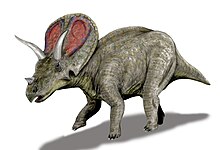Torosaurus
| Torosaurus Temporal range: Late Cretaceous
| |
|---|---|

| |
| Mounted Torosaurus, Milwaukee | |
| Scientific classification | |
| Kingdom: | |
| Phylum: | |
| Class: | |
| Superorder: | |
| Order: | |
| Suborder: | |
| Infraorder: | |
| Family: | |
| Subfamily: | |
| Genus: | Torosaurus Marsh, 1891
|
| Species | |
| |
Torosaurus (meaning "perforated lizard", commonly misinterpreted as "bull lizard") is a genus of ceratopsid dinosaur that possessed one of the largest skulls of any known land animal. The frilled skull reached 2.6 meters (8.5 ft) in length. From head to tail, Torosaurus is thought to have measured about 7.6 meters (25 ft) long and weighed 4 to 6 tonnes (4.4 to 6.6 tons).
Recent research on dinosaur ontogeny (growth and development of individuals over the life span) suggests that Torosaurus may not represent a distinct genus at all, but a mature form of Triceratops. (See discussion below.)[1]
Discoveries and species

In 1891, two years after the discovery of Triceratops, a pair of ceratopsian skulls with elongated frills bearing holes were found in southeastern Wyoming by John Bell Hatcher. Paleontologist Othniel Charles Marsh coined the genus Torosaurus for them. Similar specimens have since been found in Wyoming, Montana, South Dakota, North Dakota, Utah and Saskatchewan. Fragmentary remains that could possibly be identified with the genus have been found in the Big Bend Region of Texas and in the San Juan Basin of New Mexico. Paleontologists have observed that Torosaurus specimens are relatively uncommon in the fossil record; specimens of Triceratops are more abundant.
Although the meaning of the name Torosaurus is frequently given as 'bull lizard' (from the Latin 'taurus' (bull), the name probably means 'perforated lizard' (from the Greek word 'toreo' (pierce, perforate).[2] The allusion is to holes, or fenestrae, in the elongated frill, which have traditionally served to distinguish it from the solid frill of Triceratops. Much of the confusion over etymology of the name results from the fact that Marsh never explicitly explained it in his papers.
Two Torosaurus species have been identified:
- T. latus Marsh, 1891 (type species)
- T. utahensis Lawson, 1976
Another identification was subsequently regarded as a misassignment:
- T. gladius Marsh, 1891 (=T. latus)
(NB: Torosaurus utahensis was originally described as Arrhinoceratops utahensis by Gilmore in 1946. Review by Sullivan et al. in 2005[3] has left it as Torosaurus utahensis and somewhat older than T. latus.)
Classification and debate

Torosaurus has traditionally been classified as part of the subfamily known as Chasmosaurinae, also known as Ceratopsinae, within the family Ceratopsidae, within the Ceratopsia (which name is Ancient Greek for "horned face"), a group of herbivorous dinosaurs with parrot-like beaks which thrived in North America and Asia during the Jurassic and Cretaceous Periods. Juvenile individuals have been excavated from a bonebed in the Javelina Formation of Big Bend National Park, identified as Torosaurus cf. utahensis based on their proximity to an adult with a characteristic Torosaurus parietal.[4]
Studies have indicated that Torosaurus is most closely related to Triceratops.[5] Paleontologists investigating dinosaur ontogeny (growth and development of individuals over the life span) in the Hell Creek Formation of Montana, have recently gone a step further and identified Triceratops and Torosaurus as a single genus.
John Scannella, in a paper presented in Bristol, UK at the conference of the Society for Vertebrate Paleontology (2009 September 25) reclassified the mature Torosaurus specimens as old individuals, perhaps of a single sex, of Triceratops. Jack Horner, Scannella's mentor at Montana State University, notes that ceratopsian skulls consist of metaplastic bone. A characteristic of metaplastic bone is that it lengthens and shortens over time, extending and resorbing to form new shapes. Significant variety is seen even in those skulls already identified as Triceratops, Horner observes, "where the horn orientation is backwards in juveniles and forward in adults". Approximately 50% of all subadult Triceratops skulls have two thin areas in the frill that correspond with the placement of "holes" in Torosaurus skulls, suggesting that holes developed to offset the weight that would otherwise have been added as maturing Triceratops individuals grew longer frills.[6]
Paleobiology
All ceratopsians, including Torosaurus and Triceratops, were herbivores. During the Cretaceous flowering plants were limited in their geographical distribution. It is likely that ceratopsians fed on the more abundant ferns, cycads and conifers, using their sharp beaks to bite off leaves or needles.
In popular culture

- Torosaurus was featured in the BBC and Discovery Channel TV special Walking with Dinosaurs.
- "Torosaurus" is a nickname for Ray Toro, one of the guitarists in the band My Chemical Romance.
References
- ^ http://www.sciencedaily.com/releases/2009/10/091031002314.htm
- ^ Dodson, P. (1996). The Horned Dinosaurs. Princeton University Press, Pinceton, New Jersey, pp. xiv-346
- ^ Sullivan, R. M., A. C. Boere, and S. G. Lucas. 2005. Redescription of the ceratopsid dinosaur Torosaurus utahensis (Gilmore, 1946) and a revision of the genus. Journal of Paleontology 79:564-582.
- ^ Hunt, ReBecca K. and Thomas M. Lehman. 2008. Attributes of the ceratopsian dinosaur Torosaurus, and new material from the Javelina Formation (Maastrichtian) of Texas. Journal of Paleontology 82(6): 1127-1138.
- ^ Farke, A. A. 2006. Cranial osteology and phylogenetic relationships of the chasmosaurine ceratopsid Torosaurus latus; pp. 235-257 in K. Carpenter (ed.), Horns and Beaks: Ceratopsian and Ornithopod Dinosaurs. Indiana University Press, Bloomington.
- ^ http://www.sciencedaily.com/releases/2009/10/091031002314.htm
- Dodson, P. (1996). The Horned Dinosaurs. Princeton University Press, Princeton, New Jersey, pp. xiv-346
- Haines, Tim & Chambers, Paul. (2006)The Complete Guide to Prehistoric Life. Canada: Firefly Books Ltd.
